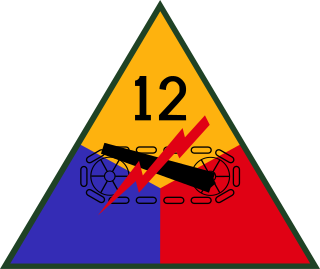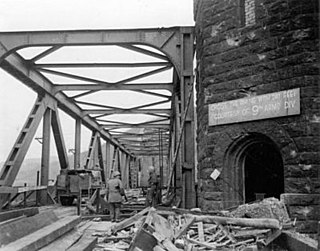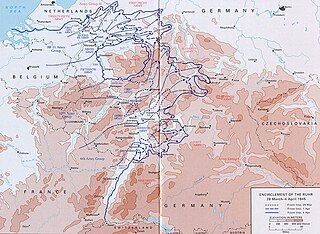
The 6th Armored Division was an armored division of the United States Army during World War II. It was formed with a cadre from the 2nd Armored Division.

The 12th Armored Division was an armored division of the United States Army in World War II. It fought in the European Theater of Operations in France, Germany and Austria, between November 1944 and May 1945.

The 14th Armored Division was an armored division of the United States Army assigned to the Seventh Army of the Sixth Army Group during World War II. It remains on the permanent roll of the Regular Army as an inactive division, and is eligible for reactivation. The division is officially nicknamed the "Liberators".

The Siegfried Line campaign was a phase in the Western European campaign of World War II, which involved actions near the German defensive Siegfried Line.

The Prague offensive was the last major military operation of World War II in Europe. The offensive was fought on the Eastern Front from 6 May to 11 May 1945. Fought concurrently with the Prague uprising, the offensive significantly helped the liberation of Czechoslovakia in 1945. The offensive was one of the last engagements of World War II in Europe and continued after Nazi Germany's unconditional capitulation on 8/9 May.

The Vistula–Oder offensive was a Red Army operation on the Eastern Front in the European theatre of World War II in January 1945. The army made a major advance into German-held territory, capturing Kraków, Warsaw and Poznań. The Red Army had built up their strength around a number of key bridgeheads, with two fronts commanded by Marshal Georgy Zhukov and Marshal Ivan Konev. Against them, the German Army Group A, led by Colonel-General Josef Harpe, was outnumbered five to one. Within days, German commandants evacuated the concentration camps, sending the prisoners on their death marches to the west, where ethnic Germans also started fleeing. In a little over two weeks, the Red Army had advanced 480 kilometres (300 mi) from the Vistula to the Oder, only 69 kilometres (43 mi) from Berlin, which was undefended. However, Zhukov called a halt, owing to continued German resistance on his northern flank (Pomerania), and the advance on Berlin had to be delayed until April.

The 9th Panzer Division was a panzer division of the German Army during World War II. It came into existence after 4th Light Division was reorganized in January 1940. The division was headquartered in Vienna, in the German military district Wehrkreis XVII.

The Colmar Pocket was the area held in central Alsace, France, by the German Nineteenth Army from November 1944 to February 1945, against the U.S. 6th Army Group during World War II. It was formed when 6th AG liberated southern and northern Alsace and adjacent eastern Lorraine, but could not clear central Alsace. During Operation Nordwind in December 1944, the 19th Army attacked north out of the Pocket in support of other German forces attacking south from the Saar into northern Alsace. In late January and early February 1945, the French First Army cleared the Pocket of German forces.

The second Jassy–Kishinev offensive, named after the two major cities, Jassy and Kishinev, in the staging area, was a Soviet offensive against Axis forces, which took place in Eastern Romania from 20 to 29 August 1944 during World War II. The 2nd and 3rd Ukrainian Fronts of the Red Army engaged Army Group South Ukraine, which consisted of combined German and Romanian formations, in an operation to reoccupy Bessarabia and destroy the Axis forces in the region, opening the way into Romania and the Balkans.

Operation Lumberjack was a military operation with the goal of capturing the west bank of the Rhine River and seizing key German cities, near the end of World War II in Europe. The First United States Army launched the operation in March 1945 to capture strategic cities in Nazi Germany and to give the Allies a foothold along the Rhine.

The Western Allied invasion of Germany was coordinated by the Western Allies during the final months of hostilities in the European theatre of World War II. In preparation for the Allied invasion of Germany east of the Rhine, a series of offensive operations were designed to seize and capture its east and west banks: Operation Veritable and Operation Grenade in February 1945, and Operation Lumberjack and Operation Undertone in March 1945; these are considered separate from the main invasion operation. The Allied invasion of Germany east of the Rhine started with the Western Allies crossing the river on 22 March 1945 before fanning out and overrunning all of western Germany from the Baltic in the north to the Alpine passes in the south, where they linked up with troops of the U.S. Fifth Army in Italy. Combined with the capture of Berchtesgaden, any hope of Nazi leadership continuing to wage war from a so-called "national redoubt" or escape through the Alps was crushed, shortly followed by unconditional German surrender on 8 May 1945. This is known as the Central Europe Campaign in United States military histories.

The XII Corps fought from northern France to Austria in World War II. Constituted in the Organized Reserves in 1933, it was activated on 29 August 1942 at Columbia, South Carolina. XII Corps became operational in France as part of Lieutenant General George S. Patton's Third Army on 1 August 1944. Initially commanded by Major General Gilbert R. Cook, bad health forced MG Cook to relinquish command to Major General Manton S. Eddy within three weeks. MG Eddy commanded the corps until late April 1945, when his own health problems forced him to turn over command to MG Stafford LeRoy Irwin.

The XX Corps of the United States Army fought from northern France to Austria in World War II. Constituted on 10 October 1943 by re-designating the IV Armored Corps of the Army Ground Forces, a training organization which had been activated at Camp Young, California on 5 September 1942, XX Corps became operational in France as part of Lieutenant General George S. Patton's U.S. Third Army on 1 August 1944.

The 39th Guards Motor Rifle Division of the Soviet Ground Forces was a mechanised infantry division active from 1965 to 1992. It was originally formed as the 39th Guards Rifle Division of the Workers' and Peasants' Red Army. It was formed during the German-Soviet War as part of the 62nd Army and assigned to the defense of Stalingrad, officially arriving at the theater in August 1942. In September the division fought through German forces which were attempting to encircle the city, and was assigned to defend the 'Volga Corridor,' the last supply line remaining for Soviet units in the city.
The 773rd Tank Destroyer Battalion was a tank destroyer battalion of the United States Army active during the Second World War.

The Battle of Kassel was a four-day struggle between the U.S. Army and the German Army in April 1945 for Kassel, a medium-sized city 140 kilometers northeast of Frankfurt am Main, which also is the second-largest city in Hesse. The battle resulted as the U.S. Third Army pushed northeast from the region of Frankfurt and Mainz. The battle opened on April 1, 1945 and ended with an American victory three days later. Opposing the Third Army's 80th Infantry Division were an infantry replacement battalion, some heavy tanks, and anti-aircraft guns. Although the Germans gave battle at Kassel, their army was on the brink of collapse as the Western Allies and the Red Army made deep inroads into Germany. The defense of Kassel did not materially impede the Allied advance, and, one month after the battle ended, Germany was forced to capitulate.

Major General Roderick Random Allen was a senior United States Army officer, who commanded the 20th and 12th Armored Divisions during World War II. Under his command of the 12th AD, the division defended Strasbourg from recapture; it provided the armored contingent in the closure of the Colmar Pocket and the liberation of Colmar; it spearheaded General George Patton's drive to the Rhine; captured intact the remaining bridge over the Danube River and broke the German defense line; and played a major part in blocking the Brenner Pass, thereby trapping over a million German soldiers in Italy as the war ended. En route to the Brenner Pass it overran eleven concentration camps at Landsberg, Germany.

Operation Pheasant, also known as the Liberation of North Brabant, was a major operation to clear German troops from the province of North Brabant in the Netherlands during the fighting on the Western Front in the Second World War. This offensive was conceived as a result of the failure of Operation Market Garden and the allied effort to capture the important port of Antwerp. It was conducted by the allied 21st Army Group between 20 October to 4 November 1944.
The 50th Guards Rifle Division was an elite infantry division of the Red Army during World War II that continued as part of the Soviet Army during the early period of the Cold War. Converted into the 50th Guards Motor Rifle Division in the late 1950s, the division was based in Brest, Belarus. After the dissolution of the Soviet Union, the division became part of the Belarusian Ground Forces and was reduced to a brigade and then a storage base before being disbanded in 2006.
The 95th Guards Rifle Division was reformed as an elite infantry division of the Red Army in May 1943, based on the 1st formation of the 226th Rifle Division, and served in that role until well after the end of the Great Patriotic War. It ended the war on the approaches to Prague and continued to serve well into the postwar era in the Central Group of Forces.

















